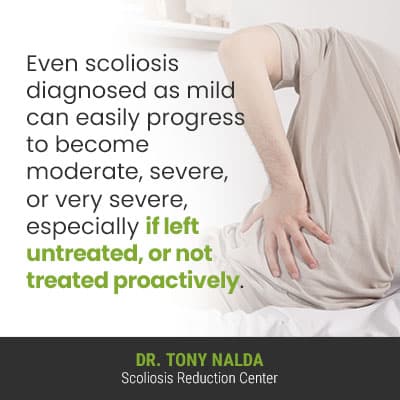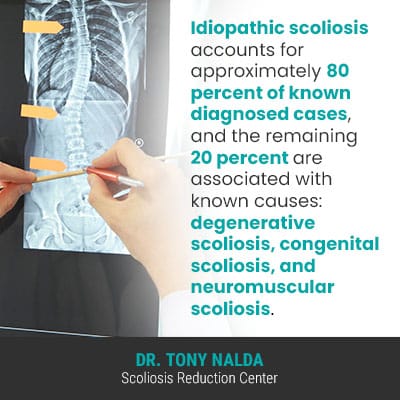What Are The 4 Types Of Scoliosis? Scoliosis Differences

Scoliosis is a complex structural spinal condition; it's deemed complex because of its wide-ranging severity levels, multiple condition types, and its progressive nature. Scoliosis has it in its nature to worsen over time, which is why proactive treatment is so important.
Scoliosis ranges widely in severity from mild to very severe, and there are also different types a person can develop, each with is own unique causation and treatment needs: idiopathic scoliosis, degenerative scoliosis, neuromuscular scoliosis, and congenital scoliosis.
Before exploring the types of scoliosis and what makes them different, let's first start with the parameters that have to be met in order to reach a diagnosis of scoliosis.
Table of Contents
Being Diagnosed with Scoliosis
Being diagnosed with scoliosis means an unnatural sideways curvature of the spine has developed.
In addition to bending unnaturally to the side, a scoliotic curve has to have a rotational component, and it's the twist from front to back, back to front, that makes scoliosis a 3-dimensional condition.
An unnatural spinal curve also has to be of a minimum size to be considered a true scoliosis: Cobb angle measurement of 10 degrees.
Cobb angle is an important factor because it tells me how far out of alignment a scoliotic spine is, in addition to classifying conditions in terms of severity:
- Mild scoliosis: Cobb angle measurement of between 10 and 25 degrees
- Moderate scoliosis: Cobb angle measurement of between 25 and 40 degrees
- Severe scoliosis: Cobb angle measurement of 40+ degrees
- Very-severe scoliosis: Cobb angle measurement of 80+ degrees
Being diagnosed with scoliosis also means living with a progressive condition that has it in its nature to worsen over time; where a scoliosis is at the time of diagnosis is not indicative of where it will stay.
 Even scoliosis diagnosed as mild can easily progress to become moderate, severe, or very severe, especially if left untreated, or not treated proactively.
Even scoliosis diagnosed as mild can easily progress to become moderate, severe, or very severe, especially if left untreated, or not treated proactively.
So in addition to classifying conditions based on severity, condition type is another key classification point that shapes the crafting of effective treatment plans.
The 4 Main Types of Scoliosis
As mentioned, there are different types of scoliosis a person can develop, and when it comes to effectively treating scoliosis, treatment plans have to be shaped by a condition's causation, when it's known.
I say "when it's known," because in the condition's most prevalent type, adolescent idiopathic scoliosis (AIS), diagnosed between the ages of 10 and 18, the idiopathic designation means we don't fully understand its etiology.
Idiopathic Scoliosis
Idiopathic is a fancy medical term that means not clearly associated with a single-known cause.
Idiopathic doesn't mean the complete absence of a cause, and in the context of idiopathic scoliosis, the condition is thought to be more multifactorial, meaning caused by multiple factors that can vary from person to person.
In addition, not knowing the cause of idiopathic scoliosis doesn't mean we don't know how to treat it or understand what triggers its progression.
We know that growth and development is the condition's main trigger, so when it comes to treating idiopathic scoliosis in children and adolescents, monitoring for, and counteracting, progression is a focus of treatment.
Idiopathic scoliosis is also the most common type of adult onset scoliosis, and idiopathic scoliosis in adult scoliosis patients are cases of AIS that went undiagnosed and untreated during adolescence.
As adults have the progressive trigger of growth removed, having reached skeletal maturity, the treatment focus is less on monitoring/counteracting progression and more on pain relief, reducing the curve back to where it was prior to becoming painful, and stabilizing the spine.
 Idiopathic scoliosis accounts for approximately 80 percent of known diagnosed cases, and the remaining 20 percent are associated with known causes: degenerative scoliosis, congenital scoliosis, and neuromuscular scoliosis.
Idiopathic scoliosis accounts for approximately 80 percent of known diagnosed cases, and the remaining 20 percent are associated with known causes: degenerative scoliosis, congenital scoliosis, and neuromuscular scoliosis.
Degenerative Scoliosis
Also known as adult de novo scoliosis, degenerative scoliosis affects adults as they age, most commonly over the age 40, and is more prevalent in women due to changes in bone density and hormones caused by menopause.
Degenerative changes to the spine are expected with age, and certain lifestyle factors such as obesity, low activity levels, chronic poor posture, and repeatedly lifting heavy objects incorrectly can increase natural levels of age-related spinal degeneration.
The spinal discs that sit between adjacent vertebrae are most often the first spinal structures to start deteriorating, and this can be in the form of disc desiccation, degenerative disc disease, bulging and/or herniated discs.
When a disc starts to degenerate, it tends to lose height, and its change in shape disrupts the spine's structure as the disc in between vertebrae is what the vertebral bodies attach to, so a disc that changes shape affects the position of adjacent vertebrae and can lead to the development of a scoliotic curve.
So degenerative scoliosis occurs in adults as they age, can be painful as the condition becomes compressive in adulthood, and requires proactive treatment that preserves spinal function, improves disc health/function, and impacts the condition on a structural level through condition-specific chiropractic care.
Neuromuscular Scoliosis
Neuromuscular scoliosis (NMS) affects all ages and is caused by the presence of a larger neuromuscular condition such as muscular dystrophy, spina bifida, cerebral palsy, and a number of connective tissue disorders.
Neuromuscular conditions disrupt brain-body communication as there is a disconnect between the brain, connective tissues, and the spinal muscles; this can lead to the development of scoliosis because it's not just the spine that's in charge of maintaining its natural curves and alignment, but also its surrounding muscles that provide it with crucial support.
Neuromuscular scoliosis patients tend to be severe cases, with some patients becoming nonambulatory (wheelchair-bound).
While not every patient with a neuromuscular condition is going to develop scoliosis, it is a common complication, and severity is determined by the degree of nerve involvement.
When it comes to treating cases of NMS, I can't give these patients the same types of prognoses I can with typical scoliosis cases because the underlying neuromuscular condition has to be the focus of treatment.
Congenital Scoliosis
Congenital scoliosis affects infants as they are born with the condition, and is a rare form affecting approximately 1 in 10, 000.
Congenital scoliosis is caused by a malformation within the spine itself that develops in utero as the spine is forming.
Oftentimes, this can involve one or more vertebrae being triangular in shape (healthy vertebrae are rectangular in shape so they can stay stacked on top of one another and stay aligned), causing it to wedge forward and disrupting the spine's ability to develop proper alignment.
In addition, vertebrae can fail to separate and form into distinct bones, instead becoming fused together, causing the spine to develop misaligned and an unnatural spinal curve to form.
There are unique challenges associated with treating congenital scoliosis based on patient age alone, and this requires modifying treatment plans and close monitoring for signs of progression, as well as issues related to any other areas of the body being malformed, and bracing when appropriate.
Conclusion
Scoliosis develops at any age and in any region of the spine: cervical spine, thoracic spine, and the lumbar spine.
Scoliosis is a complex spinal deformity to treat because it ranges so widely in severity, but also because there are multiple types of scoliosis.
The 4 main condition types are idiopathic, degenerative, congenital, and neuromuscular scoliosis.
The most prevalent type of scoliosis is adolescent idiopathic scoliosis, and as growth is the condition's main trigger for progression, early onset scoliosis that develops in early childhood and adolescents can involve rapid-phase progression: meaning a focus of treatment is on monitoring and counteracting progression.
When it comes to late onset scoliosis in adults, the focus of treatment can shift from counteracting progression, to reducing a curve back to where it was prior to becoming symptomatic, alleviating pain, preventing further deterioration, preserving spinal function, and stabilizing the spine.
While not considered one of the four main condition types, traumatic scoliosis affects people whose spines have experienced a significant trauma and/or injury; in addition, a spinal tumor can put pressure on the spine and force it out of alignment.
When it comes to the differences between abnormal spinal curves caused by varying condition types, we're talking about different age groups affected, different progressive rates, varying symptoms and condition severity, different causes and spinal regions affected: pathological scoliosis, lumbar scoliosis, thoracolumbar scoliosis, lumbar levoscoliosis, and cervical scoliosis.
Regardless of severity and type, the best time to start proactive scoliosis treatment is always now.
By being proactive with treatment, an abnormal sideways curvature of the spine can be reduced so symptoms such as pain, uneven shoulders, shoulder blades, rib cage arches, and postural deviation that disrupts the symmetry of the entire body can be improved.
Here at the Scoliosis Reduction Center, I integrate condition-specific chiropractic care to manually adjust the position of the most-tilted spinal bones, corrective bracing, physical examination and therapy for increasing core strength and targeting muscle imbalances, and rehabilitation.
Dr. Tony Nalda
DOCTOR OF CHIROPRACTIC
After receiving an undergraduate degree in psychology and his Doctorate of Chiropractic from Life University, Dr. Nalda settled in Celebration, Florida and proceeded to build one of Central Florida’s most successful chiropractic clinics.
His experience with patients suffering from scoliosis, and the confusion and frustration they faced, led him to seek a specialty in scoliosis care. In 2006 he completed his Intensive Care Certification from CLEAR Institute, a leading scoliosis educational and certification center.
About Dr. Tony Nalda
 Ready to explore scoliosis treatment? Contact Us Now
Ready to explore scoliosis treatment? Contact Us Now





